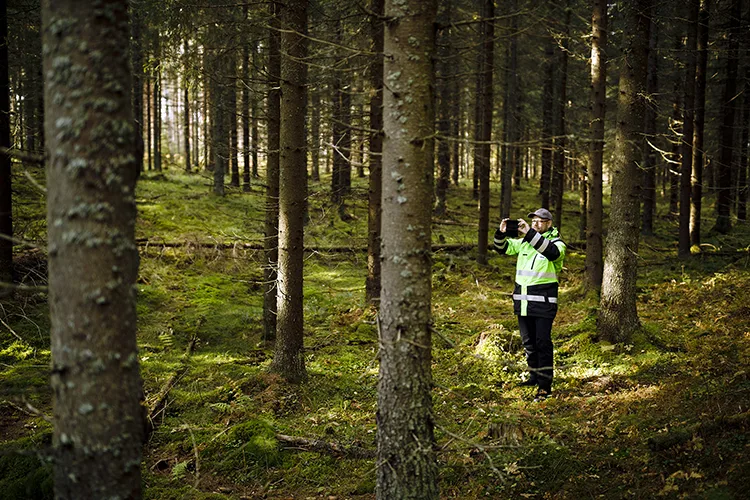
As climate change progresses, various forms of forest damage are expected to become more common. The risk of damage can be reduced by diversifying the proportions of tree species.
By Elina Hovinen and Maria Latokartano, Metsä Group
In 2015, an agreement was signed in Paris by 195 states which committed themselves to restricting the temperature rise to clearly below 2° C, and preferably below 1.5° C, compared with pre-industrial times. After nine years, it seems unlikely that the target will be achieved. In Finland, where the temperature is predicted to rise more steeply than the global average, preparations must be made for a climate up to six to eight degrees warmer than today. Seedling stands established this year will be mature in 80 years on average. The climate probably will be very different from today then. Preparations for the changes must, therefore, already be made today.
“Nationally, adapting to climate change is one of the most important tasks in Finland. Our future and the competitiveness of our bioeconomy depend on it,” says Timo Lehesvirta, leading nature expert, Metsä Group.
Climate Resilience Through Forest Management

The rising temperature and the increased carbon dioxide content in the atmosphere accelerate the growth of forests. However, at the same time, the risk of different types of forest damage increases. Forests’ ability to adapt to climate change can be improved through appropriate forest management.
Metsä Group, which also encompasses Metsä Board, adopted its regenerative forestry principles in the spring of 2023. The goal of these principles is to ensure that forests are transferred to the next generation in an increasingly vigorous and climate-resilient condition.
Increasing the diversity of tree species in forests is one of the core principles of regenerative forestry. It makes the species found in forests generally more diverse. It also is an important way to adapt to climate change.
Aiming for Mixed Forests
In recent decades, forest cultivation in Finland has favored spruce. However, forests consisting of spruce alone, are exposed to risks resulting from climate change.
The most significant risk is considered to be insect damage, especially the spruce bark beetle, which threatens both the availability of wood raw material and carbon sinks, as it spreads.
In practice, the diversification of tree species means increasing the share of deciduous trees, especially birch, in forests. Instead of a single tree species, the goal is a mixed forest consisting of several tree species.
“The spruce bark beetle does not live in deciduous trees. A forest consisting of diverse tree species diversifies the overall selection of species found in the forest, which has a generally balancing impact on biotic communities,” Lehesvirta says.
The State of Biodiversity Is Improving
In regenerative forestry, a mixed forest either can be established through cultivation, or deciduous trees can be allowed to grow naturally alongside cultivated seedlings. The main point is that deciduous trees are taken into consideration and left in the forest during all stages of forestry, from young stand management to regeneration felling.
Every tree species has its own group of species living on it, so making the tree species more diverse increases the biodiversity of forest nature.
In addition to the different tree species, trees of different ages and in different stages of decay are needed in forests, as some species are highly-specialized regarding their habitat. There are 5,000 species of organism that live on decaying wood, for example.

Understanding Nature
Globally viewed, regenerative forestry is an exceptional way to practice the bioeconomy, according to Lehesvirta.
“In regenerative forestry, tree species used industrially are grown as part of an ecosystem with conditions to which the trees have adapted during their evolution. This approach is fundamentally different from mainstream land use such as cultivated forests and plantations that are based on changing the land use and removing the original nature. We can organize the production of raw material on an industrial scale in a way that allows the majority of the area’s original species to continue to occur in the ecosystem despite the production.”
The goal of regenerative forestry is to strengthen forests’ vitality, biodiversity and climate resilience. When this goal is achieved, economic growth will no longer entail the decrease of the state of nature. Instead, forests can be used so that they simultaneously provide raw material, food and recreation, act as carbon sinks, clean water and air, and combat erosion.
“Regenerative forestry offers a very interesting answer to the question of how to use land when faced with the current environmental challenges. It also is a good example of Metsä Group’s efforts to operate in a way that shows a better understanding of nature.”
This article was originally printed in the Metsa Board Magazine – Spring 2024 edition. https://boardmagazine.metsagroup.com/view/149858928/32/#zoom=true
Artificial Intelligence Detects the Early Stage
of Forest Damage
Metsä Group and the AI developer Collective Crunch have developed an application that makes it easier to identify and visualize insect damage.
The application is based on artificial intelligence and remote surveying data. It detects changes that indicate that trees are under heavy stress and point to early forest damage. The application shows the area of damage in red on a map and estimates both the probability and severity of the damage.
The application can identify the early stage of forest damage even earlier than the human eye, making it possible to prevent the expansion of the damage.
Metsä Group’s forest owner members can use the application through the Metsäverkko service. Metsäverkko is a free online service that facilitates forest owners’ management of their forest assets.
The damage detection application was chosen as the innovation of the year in the Quality Innovation Award 2023 competition, both in Finland and internationally.

